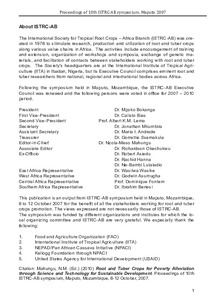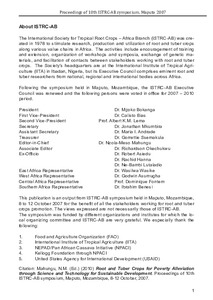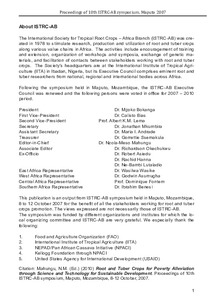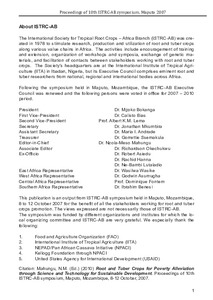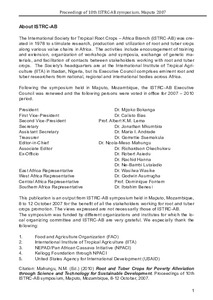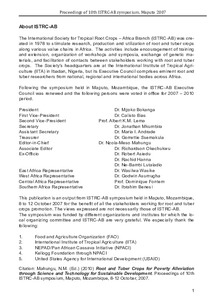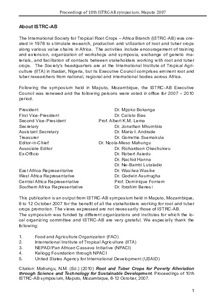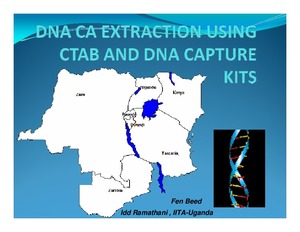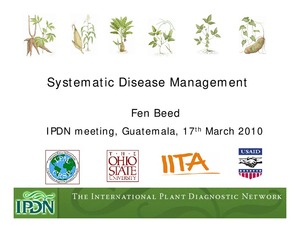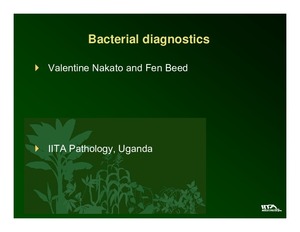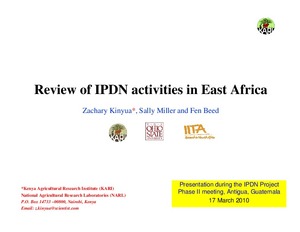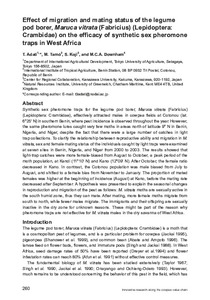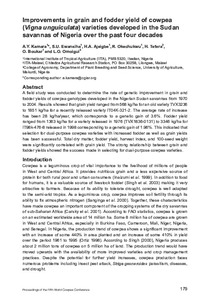Welcome to the International Institute of Tropical Agriculture Research Repository
Conference Documents: Recent submissions
Now showing items 541-560 of 597
-
Sustainable approach for cassava processing in Africa
(International Institute of Tropical Agriculture, 2010)Cassava plays important roles. It is a famine reserve crop, a staple food for the rural populace and a cash crop for urban consumption. It is a source of industrial raw materials and earns foreign exchange. Unfortunately, the past decades witnessed too much emphasis on the production components of the research industry in Africa. Yesterday, traditional processing offered a low value, poor quality product and used poor storage methods with a low investment drive to restricted consumers. Today, a ... -
Iron bioavailability and utilization in rats fed cassava-based complementary diets
(International Institute of Tropical Agriculture, 2010)Iron deficiency anaemia is still a major nutritional problem in the world, affecting primarily infants, children, and fertile women in both developing and developed countries (UNICEF, 2006). Breast-fed infants generally have adequate iron status during the first 4-6 mo of life, after which stored iron is depleted. Additional dietary iron therefore needs to be supplied. Improved cassava–based diets can provide a large proportion of the daily intake of energy and micronutrients for poor populations ... -
Application of molecular marker-assisted selection in breeding for improved farmer/market preferred cassava varieties in Tanzania
(International Institute of Tropical Agriculture, 2010)Tanzania is the fifth largest producer of cassava in Africa, the eighth largest producer in the world with an estimated average yields of about 10.4 t/ha, which is far below the potential yield of the crop. The low yield is caused by a number of factors including susceptibility of commonly grown varieties to major diseases and pests including susceptibility of local varieties to major diseases and pests such as cassava mosaic diseases (CMD), caused principally by East African Cassava Mosaic Virus ... -
Introduction and evaluation of improved varieties of Dioscorea rotundata, and D. cayenensis with high micronutrient content in Cameroon
(International Institute of Tropical Agriculture, 2010)Yam (Dioscorea sp.) is an extremely important delicacy in Cameroon, with some estimated 45,215 hectares devoted to it, and corresponding annual production of 275,101 metric tons. Production is constrained by several factors including the limited availability and cost of planting material, as well as susceptibility to a range of pests and diseases that cause considerable pre- and post- harvest losses, translated into low yields and poor quality of tubers during storage. With the development of new ... -
Evaluation of the performance of five hybrid water yam clones in the yam belt of Nigeria
(International Institute of Tropical Agriculture, 2010)The performance of 5 promising pre-release hybrid water yam (D. alata) varieties (TDa 98/01166; TDa 98/01176; TDa 98/01168; TDa 99/91169; and TDa 99/00240) evaluated for high and stable yields, pest and disease resistance and desirable food qualities, was determined in 2004 and 2005 in 6 locations in the Nigerian yam belt. The trials were laid out in randomized complete block design in three replications in each location. The results from two year fresh tuber yield and disease severity scores show ... -
Feeding and economic value of cassava starch by-products to growing fattening pigs
(International Institute of Tropical Agriculture, 2010)An experiment was conducted to evaluate the feeding and economic value of cassava starch by-products as source of energy in diets for growing fattening pigs. Cassava starch by-products were incorporated in the diets at 0 (treatment 1, control), 10 (treatment 2), 20 (treatment 3) and 30% (treatment 4). Each treatment had three replicates arranged as unbalanced incomplete block design. Pigs fed treatment 4 had the highest (p<0.05) feed intake (23.05), body weight gain (62.90) and growth efficiency ... -
Towards improving the nutritional quality of cassava: progress in the genetic enhancement of carotenoids, iron, zinc, and protein levels
(International Institute of Tropical Agriculture, 2010)Though cassava (Manihot esculenta Crantz) is a staple for many poor people in Africa, it has major nutritional disadvantages. The tuberous root has very low levels of essential nutrients. Consequently, malnutrition is widespread among the people who depend on as a staple in their diet. Breeding cassava for enhanced nutritional quality and making such biofortified varieties available to endusers could help prevent related deficiencies. This paper presents experiences and progress in the genetic ... -
The incidence of the cassava mosaic disease in relation with the source of planting materials and its impact on cassava production
(International Institute of Tropical Agriculture, 2010)An experiment was conducted over two years (in 2004 and 2005) at the research station of the National Institute of Agricultural Study and Research (INERA) in Mvuazi, Bas-Congo province to determine the incidence of the cassava mosaic disease (CMD) in relation to the source of planting material and its impact on cassava yield. In the first year, two treatments were assessed, (1) healthy cuttings obtained from plots managed with phytosanitation through rouging and, (2) cuttings collected at random ... -
Effect of cassava leaf harvesting on root yield and quality
(International Institute of Tropical Agriculture, 2010)Cassava leaves are increasingly becoming an important source of nutrition for both human beings and livestock. A study was conducted at Chitedze Research Station, Malawi, to determine the effects of leaf harvesting on root yield and quality from 2003/04 to 2005/06 season. Two cassava varieties were used which included Mbundumali, a sweet variety with low potential for cyanogenic glucosides and widely grown by farmers; and Silira (TMS 60142B) an improved variety which is bitter, originated from ... -
Linking farmers to markets: opportunities and challenges for cassava farmers in Malawi
(International Institute of Tropical Agriculture, 2010)In an effort to improve rural farmer’s livelihood, many initiatives have been initiated in Sub-Saharan Africa (SSA) to link cassava farmers to markets. Several models have been used including use of leading entrepreneurs, targeting farmers’ associations/groups, conducting industrial tests to sensitize and create new markets, use of out-growers scheme and use of farmer-to –trader linkages. These models have been applied for a range of value chains in the cassava industry including starch, high ... -
DNA CA extraction using CTAB and DNA capture kits
(International Institute of Tropical Agriculture, 2010-01) -
Systematic disease management
(International Plant Diagnostic Network, 2010) -
Bacterial diagnostics
(International Institute of Tropical Agriculture, 2010) -
Review of IPDN activities in East Africa
(International Plant Diagnostic Network, 2010) -
Analyses of different processes governing soil erosion by water in the tropics
(International Association of Hydrological Sciences, 1981-06)Soil erosion hazard in tropical Africa is a serious threat towards sustained productivity. The available basic research information on soil, climate, and land use is rather sketchy and indicates that the severity of the erosion hazard may be attributed to soil characteristics, low soil loss tolerance, and climatic factors that lead to accelerated soil erosion following a change in land use. Researchers in the tropics have yet to establish appropriate methods for monitoring and estimating, precisely ... -
The impact of the emergency response to the outbreak of the cassava mosaic disease in the Democratic Republic of Congo
(International Society For Tropical Root Crops-Africa Branch, 2012-02)This paper evaluates the impact of an emergency research for development project implemented in the Democratic Republic of Congo from 2000 to 2009 by a various actors including the International Institute of Tropical Agriculture in response to the outbreak of the Cassava Mosaic Disease that threatened the national food security. It applies methods developed in the econometric and statistical treatment effects literature on evaluation of social programs. The study evaluates impact by analyzing ... -
An historical review of progress to control key cowpea biotic constraints in Burkina Faso
(International Institute of Tropical Agriculture, 2012)Cowpea farming practices have been ongoing for millennia and have always faced various challenges including diseases, insects, and weeds, that lower its yield to no more than 200 kg/ha. This economically and nutritionally important crop has been a major research focus of the International Institute of Tropical Agriculture (IITA) and of several national agricultural research systems (NARS) in sub-Saharan Africa (SSA) and partner universities. Researchers have begun to develop sustainable solutions ... -
Effect of migration and mating status of the legume pod borer, Maruca vitrata (Fabricius) (Lepidoptera: Crambidae) on the efficacy of synthetic sex pheromone traps in West Africa
(International Institute of Tropical Agriculture, 2012)Synthetic sex pheromone traps for the legume pod borer, Maruca vitrata (Fabricius) (Lepidoptera: Crambidae), effectively attracted males in cowpea fields at Cotonou (lat. 6°25' N) in southern Benin, where pest incidence is observed throughout the year. However, the same pheromone lures caught very few moths in areas north of latitude 9° N in Benin, Nigeria, and Niger, despite the fact that there were a large number of catches in light trap collections. To clarify the relationship between reproductive ... -
Improvements in grain and fodder yield of cowpea (Vigna unguiculata) varieties developed in the Sudan savannas of Nigeria over the past four decades
(International Institute of Tropical Agriculture, 2012)A field study was conducted to determine the rate of genetic improvement in grain and fodder yields of cowpea genotypes developed in the Nigerian Sudan savannas from 1970 to 2004. Results showed that grain yield ranged from 568 kg/ha for an old variety TVX3236 to 1851 kg/ha for a recently released variety IT04K-321-2. The average rate of increase has been 28 kg/ha/year, which corresponds to a genetic gain of 3.6%. Fodder yield ranged from 1363 kg/ha for a variety released in 1976 (TVX1836-0131) ...

